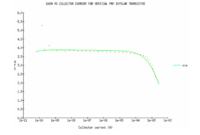mona123
Member level 5
gm of BJT is 40*Ic. So does it mean gm is independent of device size and shape? So I can get same gm with smaller device and larger device for same amount of current applied? Then why would one use large devices? Thanks.
Follow along with the video below to see how to install our site as a web app on your home screen.
Note: This feature may not be available in some browsers.


gm of BJT is 40*Ic. So does it mean gm is independent of device size and shape? So I can get same gm with smaller device and larger device for same amount of current applied? Then why would one use large devices? Thanks.
No it's a basic quantity in many design calculations. But other real word parameters need to considered additionally. You can find out yourself by reviewing design excercise problems in text books.So is gm a useless quantity in BJT then?
I don't know about your text books. Mine are using gm in many places, e.g. Analysis and Design of Analog Integrated Circuits by Gray/Hurst/Lewis/Meyer. The role of the parameter gm corresponds to the description of the transistor as voltage controlled current source in basic transistor models. gm isn't but the derivative of Ic = f(Vbe).If it was clear in text book, i wouldn't have asked hereIf you know a particular section of a textbook that describes the importance of gm in BJT, that will be helpful. Thanks.
Trans conductance is not directly used in a BJT but in other forms in h parameter model design
the model you
who is "you"?
are talking about is Z model and the one I meant was H representation of Tranny that is all the difference that is the reason why some of the books he referred are not having the ame in question
- - - Updated - - -
and do you mean hoe as trans conductance
Yes Gm is the inverse of resistance
R = V/I
Gm = I/V, which is why i said it determines how well voltage can be transferred into current, i was not wrong in what i said
I see several inaccuracies involved with the expression.R = V/I
Gm = I/V, which is why i said it determines how well voltage can be transferred into current, i was not wrong in what i said
Ic = f(Vbe)
gm = dIc/dVbero = dVce/dIc